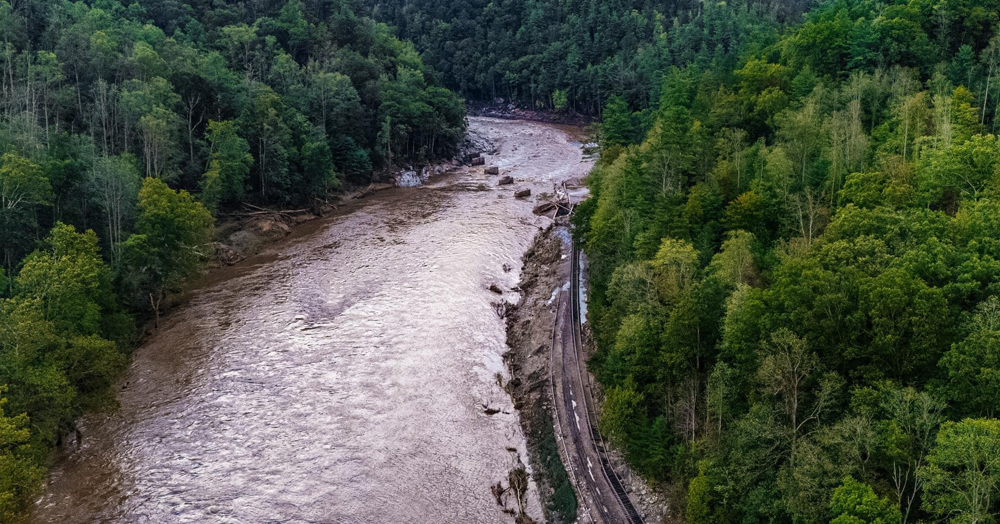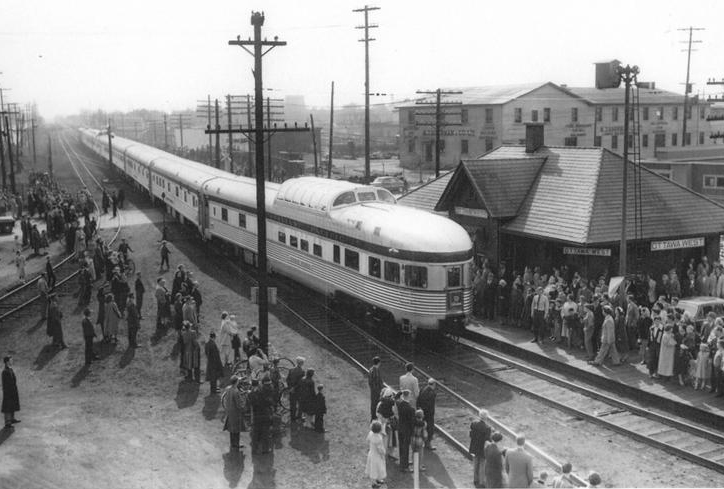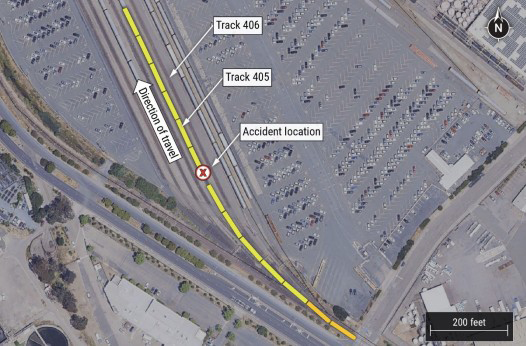
ERWIN, Tenn. — Whitewater rafting advocates have filed lawsuits claiming the federal government has unlawfully allowed CSX Transportation to rebuild its former Clinchfield through the Nolichucky River Gorge and that the railroad’s repairs are environmentally disruptive.
CSX has been rebuilding 40 miles of its Blue Ridge Subdivision between Erwin, Tenn., and Spruce Pine, N.C., after substantial portions were destroyed by Tropical Storm Helene in late September [see “CSX’s former Clinchfield largely unrecognizable…,” Trains News Wire, Sept. 28, 2024].
The whitewater rafting groups claim the federal government rubber-stamped CSX’s permitting processes, approved work that is unlawful, and allowed the railroad to reconstruct the route without certain permits. The groups are concerned the railroad’s alleged use of rock from the riverbed to rebuild the right-of-way, as opposed to quarried rock, will disrupt the river’s channel and its future navigability by rafters. They also claim heavy construction equipment is being used in a documented area known for a critically endangered colony of freshwater mussels.
Two nonprofit groups, American Whitewater and American Rivers, have filed suit against the U.S. Fish and Wildlife Service, the U.S. Army Corps of Engineers, and the U.S. Forest Service, with the Southern Environmental Law Center serving as counsel. The suit was filed in the U.S. District Court for the Western District of North Carolina in Asheville on Nov. 18.
Specifically, the lawsuit alleges unlawful approvals issued by the Army Corps of Engineers and the Forest Service, and an unlawful determination by the Fish and Wildlife Service regarding the authorization of repairs. The groups have called into question the legitimacy of the railroad’s permitting with these agencies and whether the work is being conducted in accordance with environmental laws like the Clean Water Act, the Harbors Act, and Forest Service Organic Act, which the federal agencies have jurisdiction to enforce.
Court records also allege the railroad began its reconstruction without informing the agencies, and is operating its equipment and excavating material on and in Forest Service-managed lands and waters outside of the railroad’s right-of-way without special-use permits. The groups say these actions threaten irreplaceable damages to the Nolichucky River Gorge. In one instance, court records reference a makeshift haul road that was constructed across the river to transport fill material on the opposite side of the river where the railroad is being rebuilt.
The groups have asked CSX to stop its repairs until environmental concerns are adequately addressed.
In a statement to Trains News Wire, CSX said, “The U.S. Army Corps of Engineers (USACE) Nashville and Wilmington Districts, as well as state agencies, were notified of the significant impacts to our infrastructure on the Blue Ridge Subdivision and our plans to initiate reconstruction. The USACE Nashville District issued emergency authorization and Tennessee Department of Environment and Conservation issued an emergency permit for repair and reconstruction.
“CSX has been providing information to both USACE Districts. CSX continues to work collaboratively with the USACE, USDA Forestry Service, U.S. Fish & Wildlife, and state agencies to ensure the recovery and restoration is conducted in a safe and environmentally responsible way.”
The railroad also responded to the whitewater groups’ claims CSX is using bedrock from the Nolichucky River.
“Track material is being recovered from the Nolichucky River, which includes rail, ties, track panels, rock, bridge spans and other rail bed fill material that was washed into the river as a result of the historic flooding. CSX is recovering and using the rock that was deposited at select locations in the river to stabilize the rail line in areas severely eroded by the flood. CSX continues to work with regulatory agencies to ensure environmental protections are in place and prioritizes methods that limit the effect on the river.”
The railroad says it has deployed a team of engineers and environmental specialists to support recovery efforts, adding that CSX is committed to environmental compliance and “strives to protect the environment and the safety and health of the public, customers, and employees in all aspects of the company’s operations,” noting that its decisions are guided by principles in its environmental policy.
“CSX will continue working with the U.S. Army Corps of Engineers and other regulatory agencies throughout the recovery and restoration process.”
The whitewater groups say they do not oppose rebuilding of the railroad, but are adamant CSX should source rock from other locations as opposed to mining rock from the riverbed, and that its repairs should be in accordance with environmental laws, and every effort should be made to restore the area to pre-emergency conditions.
“We want CSX to be able to quickly rebuild its damaged rail lines, but it needs to do so in a responsible way that follows the law and protects our communities,” Patrick Hunter, managing attorney of the Southern Environmental Law Center’s Asheville, N.C., office, said in a press release.
“As we recover from Helene, we need to work together to rebuild resiliently. Instead, CSX is making shortsighted decisions that will worsen flooding problems for people living downstream and do permanent damage to this incredible river.”
The rail line remains out of service nearly two months after Helene made landfall, forcing railroaders into temporary transfers outside of their home terminals.The railroad anticipates it will spend more than $200 million to rebuild the former Clinchfield, which it says handles about 14 million tons of freight each year. Rail service may not be restored until early 2025.
CSX has created a dedicated webpage, Blue Ridge Subdivision Recovery, to provide updates on the repair efforts.














sue the hurricane!
The court should immediately throw this suit out on summary judgment with prejudice. I love to paddle but jobs should always be more important than a sport. Work always trumps play.
It’s an emergency situation. Rules change CSX is attempting to recover it’s property that was washed away. The river has been changed by the flooding and will be changed by future flooding. So what if CSX takes some rock to stabilize their ROW.
If the rocks were originally part of the Clinchfield right of way then the rafters have no argument with the railroad, CSX is just putting their property back where it belongs!!! Is that not what all in NC/SC (my farm included) have been trying to do since the storm. Some folks need to get a life and be considerate of others.
Love whitewater rafting yet these groups are way out of bounds with this one.
Weren’t those rocks that ones that washed into the river from the riverbanks? CSX is just putting them back. Environmental restoration!
“The whitewater groups say they do not oppose rebuilding of the railroad, but are adamant CSX should source rock from other locations as opposed to mining rock from the riverbed, and that its repairs should be in accordance with environmental laws, and every effort should be made to restore the area to pre-emergency conditions.” What the heck do you think they are doing? Putting High Speed rail through the area? This law suit should have been really filed by the Southern Environmental Law Center’s since they are really the ones stirring the waters here. They are probably mad that all the public comment and input opportunities into permitting this work was nulled out as in normal circumstances. WELL SO WHAT! IT WAS A FREAKING EMERGENCY and NATURAL DISASTER! The Corp of Engineers, USF&WS and Forest Service were all kept in the loop and technically only the USACE would require any permitting because they govern ALL issues with all of the nations waterways, whether navigable or not. Next they will want God to get a permit next time he allows a severe storm of any type or an earthquake to upset a few weekend warriors or some mussel so insignificant that most people didn’t even know it existed in the first place. And Charles, why let a little thing like location affect standing, after all these are major tree huggers we are talking about! lol. Liberalism run amok…
I wish I could love this comment. I couldn’t agree more.
Thank you for mentioning the mussels. They need an advocate. I would offer to fly them to a destination of their choice, then provide hotel accomodations, cell phones, and debit cards. Not much time left to get this done.
And who knows the removal of rocks just might change the water flow so that the brats might like it after all (bunch of spoiled brats regardless !!!) just a note I’ve whitewater canoeing back in the days……
I did some whitewater rafting in my younger days. If CSX is basically removing what went into the water, the water flow on that part of the river should not be effected that much. However, it is very possible that there are small companies providing rafts & guides who make a living from the rafting. If CSX is destroying their operations then I can understand the concern. Also, good whitewater rafting areas, particularly those that can operate much of the year, are not common.
I do agree that it might be possible to actually make at least the part of the effected river area better for whitewater rafting if cooperation between all parties would take place.
Oh Good Grief……it is any wonder anything gets done. Now we have brats who want to play in the water stamping their feet like a bunch of spoiled brats.
And their standing in court is what exactly? Wouldn’t the court suit have to come from North Carolina DNR?
Their “standing” is the precedent set by previous court actions and legislation paid for by organized pleasure groups. Recreation is big business to be sure but when “fun” takes precedence over the National Interest then we have a problem.